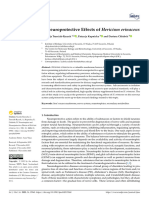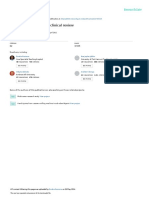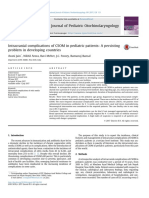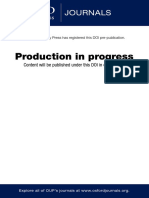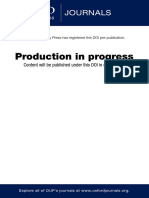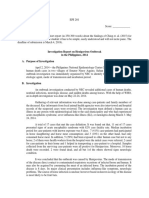152 409 1 PB
152 409 1 PB
Uploaded by
Rendra Syani Ulya FitriCopyright:
Available Formats
152 409 1 PB
152 409 1 PB
Uploaded by
Rendra Syani Ulya FitriOriginal Description:
Original Title
Copyright
Available Formats
Share this document
Did you find this document useful?
Is this content inappropriate?
Copyright:
Available Formats
152 409 1 PB
152 409 1 PB
Uploaded by
Rendra Syani Ulya FitriCopyright:
Available Formats
See discussions, stats, and author profiles for this publication at: https://www.researchgate.
net/publication/320008708
Coenurosis on Central Nervous System
Article · September 2017
CITATIONS READS
0 18
2 authors:
Emda Zein Cik Fitria Yudha Nurdian
Universitas Jember Universitas Jember
8 PUBLICATIONS 0 CITATIONS 622 PUBLICATIONS 549 CITATIONS
SEE PROFILE SEE PROFILE
Some of the authors of this publication are also working on these related projects:
Leishmania donovani: The Cause of Central Nervous System Implication in Visceral Leishmaniasis View project
tutorial neurobehavior View project
All content following this page was uploaded by Emda Zein Cik Fitria on 24 September 2017.
The user has requested enhancement of the downloaded file.
Coenurosis on Central Nervous System
1
Emda Zein Cik Fitria and 2Yudha Nurdian
1
Student, Faculty of Medicine, University of Jember, Indonesia
2
Faculty of Medicine, University of Jember, Indonesia
Corresponding author: Emda Zein Cik Fitria, emdazein@gmail.com;
152010101119@students.unej.ac.id
Abstract
Background
Coenurosis is caused by infestation with the coenuri (metacestode or larval stage) of Taenia
multiceps, T. serialis, T. brauni, and T. glomerata. These four Taenia species are present in
the Americas, Europe, and Africa. Canids are the definitive hosts and a variety of mammals
as intermediate hosts. Human infestation results from accidental ingestion of eggs in
contaminated food or water. There are approximately 30 cases of human CNS coenurosis
reported in the scientific literature in South Africa, Europe, India, the USA, Brazil, and Israel.
T. multiceps is the only species reported to cause human CNS infection. Cerebral infestation
due to T. serialis has been reported in sheep. T. brauni has been reported in Central and South
Africa. T. glomeratus has been detected in the brain of nonhuman primates. Human CNS
infestation usually presents with severe headache, disturbances of personality, weight loss,
nuchal rigidity, and intracranial hypertension. Hemiparesis, weakness, and papilledema are
also common. The most effective treatment is surgery, and is often used to relieve intracranial
hypertension and remove the source of inflammation. Antiparasitic therapy with albendazole
and praziquantel has been successful in some patients.
Conclusion
This work explains how could coenuri infest humans and cause CNS infestation symptom.
Although, only T. multiceps reported to cause human CNS infestation, the other coenuri (T.
serialis, T. brauni, and T. glomerata) also noted to be the risk of infestation.
References
Lescano, A. G. and Zunt, J. 2013. Other Cestodes: Sparganosis, Coenurosis and Taenia
crassiceps Cysticercosis. In: Aminoff, M. J., Boller, F., and Swaab, D. F. (Eds.). Handbook
of Clinical Neurology, Vol. 114, Amsterdam: Elsevier. p. 335-345.
View publication stats
You might also like
- Rare Involvement of Herpes Zoster in The Mandibular Branch of The Trigeminal Nerve: A Case Report and Review of The LiteratureDocument9 pagesRare Involvement of Herpes Zoster in The Mandibular Branch of The Trigeminal Nerve: A Case Report and Review of The Literaturemanish patilNo ratings yet
- Approach To The Child With ComaDocument10 pagesApproach To The Child With Comapradeepgullipalli.1089No ratings yet
- Wu,2024Document12 pagesWu,2024David Ramirez MedNo ratings yet
- Prevención y Manejo Del Delirio en La Unidad de Cuidados IntensivosDocument15 pagesPrevención y Manejo Del Delirio en La Unidad de Cuidados Intensivosvalentina briceño contrerasNo ratings yet
- Disorders of Peripheral Nerves, From Beginning To EndDocument2 pagesDisorders of Peripheral Nerves, From Beginning To EndFlea CidNo ratings yet
- Nihms 1646158Document30 pagesNihms 1646158darlingcarvajalduqueNo ratings yet
- Infectious Keratitis: An Immediate Cause of Concern: January 2017Document7 pagesInfectious Keratitis: An Immediate Cause of Concern: January 2017anditaplsNo ratings yet
- MDER 59124 Peripheral Nerve Conduits Technology Update 120114Document21 pagesMDER 59124 Peripheral Nerve Conduits Technology Update 120114YEAP CHING YEE BN20110072No ratings yet
- Brain Tumors: Epidemiology and Current Trends in Treatment: September 2015Document22 pagesBrain Tumors: Epidemiology and Current Trends in Treatment: September 2015lameck phiriNo ratings yet
- Ref 1Document5 pagesRef 1Nanda SapitriNo ratings yet
- Neurocysticercosis - A Case Report and Brief Review - Jasmin Ahmed - Academia - EduDocument3 pagesNeurocysticercosis - A Case Report and Brief Review - Jasmin Ahmed - Academia - EduSarahMillardNo ratings yet
- Dengue Convalescent Rash in Adult Indonesian PatieDocument3 pagesDengue Convalescent Rash in Adult Indonesian PatiedrlazyboyNo ratings yet
- JNeurosciRuralPract 2013 4 5 67 116472Document17 pagesJNeurosciRuralPract 2013 4 5 67 116472lathifatulNo ratings yet
- JurnalDocument4 pagesJurnalGaluh M ArtamtiNo ratings yet
- Epilepsy in Tropics: Indian Perspective: Review ArticleDocument5 pagesEpilepsy in Tropics: Indian Perspective: Review ArticleBoyke SitompulNo ratings yet
- Neurological Disorders: Causes and Treatments Strategies: April 2018Document10 pagesNeurological Disorders: Causes and Treatments Strategies: April 2018Friska HarianjaNo ratings yet
- Tubo Neural PDFDocument24 pagesTubo Neural PDFcristyNo ratings yet
- Tuberculous Meningitis and HydrocephalusDocument10 pagesTuberculous Meningitis and HydrocephalusDwi Ayu KusumawardaniNo ratings yet
- Cancer Reports - 2024 - Menlibayeva - Study of The Stress in Adults Diagnosed With Meningioma Insights From A TertiaryDocument12 pagesCancer Reports - 2024 - Menlibayeva - Study of The Stress in Adults Diagnosed With Meningioma Insights From A TertiaryGayatri BodadeNo ratings yet
- Tree in BudDocument3 pagesTree in BudChakradhar ChakrreNo ratings yet
- Otitis Externa: Continuing Medical EducationDocument12 pagesOtitis Externa: Continuing Medical EducationWindy SengiNo ratings yet
- Neurological Disorders: Causes and Treatments Strategies: April 2018Document10 pagesNeurological Disorders: Causes and Treatments Strategies: April 2018nmafavour2No ratings yet
- ChinJPhysiol646257-5848703 161447 PDFDocument9 pagesChinJPhysiol646257-5848703 161447 PDFAndrea OrbeNo ratings yet
- Slide Eritroderma 2Document7 pagesSlide Eritroderma 2Anonymous QqGJk2jK5No ratings yet
- Neurologic Emergency Outcome and Associated Factors in A Hawassa University Comprehensive Specialized Hospital EthiopiaDocument6 pagesNeurologic Emergency Outcome and Associated Factors in A Hawassa University Comprehensive Specialized Hospital EthiopiaMOHAMAD FAKIHNo ratings yet
- 1 s2.0 S2772973723009013 MainDocument8 pages1 s2.0 S2772973723009013 MainMDrakeNo ratings yet
- InfectiousmeningitisDocument10 pagesInfectiousmeningitisHow ToNo ratings yet
- Melioidosis Quan TrongDocument5 pagesMelioidosis Quan TrongTien NguyenNo ratings yet
- Jurnal PolyneuropatiDocument11 pagesJurnal PolyneuropatiMeutia Siti ZaharaNo ratings yet
- NTDs in New BornsDocument6 pagesNTDs in New BornsHirut TeshaleNo ratings yet
- ArticleDocument9 pagesArticleMaría José TvNo ratings yet
- Kegawatdaruratan Emergency DBD AnakDocument2 pagesKegawatdaruratan Emergency DBD AnakTheresia ChesarNo ratings yet
- Current and Future Treatments in Alzheimer Disease: An UpdateDocument12 pagesCurrent and Future Treatments in Alzheimer Disease: An Updatefenilpatel082002No ratings yet
- INGLÉS - Efectos Neurotróficos y Neuroprotectores de Hericium ErinaceusDocument29 pagesINGLÉS - Efectos Neurotróficos y Neuroprotectores de Hericium ErinaceusLilyNo ratings yet
- Deep Vein Thrombosis: A Clinical Review: Hematology Research and Reviews April 2011Document12 pagesDeep Vein Thrombosis: A Clinical Review: Hematology Research and Reviews April 2011ayuNo ratings yet
- Intensive Care Managementof Tetanus Current Strategiesand ChallengesDocument11 pagesIntensive Care Managementof Tetanus Current Strategiesand Challengesداریوش بستامNo ratings yet
- How Do I Manage Nocardiosis?Document9 pagesHow Do I Manage Nocardiosis?Dan JaiNo ratings yet
- Frequency of Migraine and Its Associated Triggers.24Document7 pagesFrequency of Migraine and Its Associated Triggers.24Qurat-ul-ain IrfanNo ratings yet
- Hidradenitis SupuratifDocument12 pagesHidradenitis SupuratifRielz Thereaperz100% (1)
- Ni02113 PDFDocument11 pagesNi02113 PDFAlicia NataNo ratings yet
- SgnsDocument11 pagesSgnsMelfi RiqqahNo ratings yet
- Pharmaceuticals 15 01077Document26 pagesPharmaceuticals 15 01077Kugendran VRNo ratings yet
- Sedation in Pediatric Dentistry: January 2019Document8 pagesSedation in Pediatric Dentistry: January 2019Ina Vetrila100% (1)
- Fungal Infections of The Central Nervous SystemDocument465 pagesFungal Infections of The Central Nervous SystemLai QlocNo ratings yet
- Delirium NatureDocument26 pagesDelirium NatureRodrigoNo ratings yet
- Abba Musa Abdullahi Viral Infections of The CentralDocument9 pagesAbba Musa Abdullahi Viral Infections of The Centralcesar galvez lopezNo ratings yet
- Pathology of Multiple Sclerosis: CNS & Neurological Disorders Drug Targets May 2012Document13 pagesPathology of Multiple Sclerosis: CNS & Neurological Disorders Drug Targets May 2012jhidalgomdNo ratings yet
- Understanding and Managing Acute EncephalitisDocument10 pagesUnderstanding and Managing Acute EncephalitisAkila SwaminathanNo ratings yet
- 1 s2.0 S0165587617302975 Main PDFDocument4 pages1 s2.0 S0165587617302975 Main PDFAchmad YunusNo ratings yet
- Neuropatía ReumatoideDocument9 pagesNeuropatía ReumatoideJorge GámezNo ratings yet
- Dyspnea in Emergency Settings Up To Date.7Document8 pagesDyspnea in Emergency Settings Up To Date.7Ria MasihNo ratings yet
- The Influence of Pituitary Adenomas On VisionDocument2 pagesThe Influence of Pituitary Adenomas On VisionScivision PublishersNo ratings yet
- Preprints202309 0487 v1Document23 pagesPreprints202309 0487 v1Saul EstrellaNo ratings yet
- Abcess Cerebri Pada AnakDocument6 pagesAbcess Cerebri Pada AnakSannita Mayusda BadiriNo ratings yet
- Meningitis Ein 3Document42 pagesMeningitis Ein 3Rifqi FuadiNo ratings yet
- Fungal EndocarditisDocument4 pagesFungal EndocarditisJorgeNo ratings yet
- Manajemen EpistaksisDocument2 pagesManajemen EpistaksistiaraaaindahNo ratings yet
- Occipital Meningoencephalocele Case Report and RevDocument5 pagesOccipital Meningoencephalocele Case Report and RevCindikia Ayu SNo ratings yet
- The Complete Handbook on Meningitis: Prevention, Care, and Recovery: The NeuroHealth Collection: Understanding Diseases of the Nervous System, #8From EverandThe Complete Handbook on Meningitis: Prevention, Care, and Recovery: The NeuroHealth Collection: Understanding Diseases of the Nervous System, #8No ratings yet
- Clinical Handbook of Neuromuscular MedicineFrom EverandClinical Handbook of Neuromuscular MedicineDavid WalkNo ratings yet
- Neuroimage: ClinicalDocument7 pagesNeuroimage: ClinicalRendra Syani Ulya FitriNo ratings yet
- Fluid Balance Emma BoxallDocument13 pagesFluid Balance Emma BoxallRendra Syani Ulya FitriNo ratings yet
- Randomized Controlled Trials of Vitamin D and Cancer Incidence: A Modeling StudyDocument14 pagesRandomized Controlled Trials of Vitamin D and Cancer Incidence: A Modeling StudyRendra Syani Ulya FitriNo ratings yet
- Generation of The Scn1A Epilepsy Mutation in Hips Cells Using The Talen TechniqueDocument8 pagesGeneration of The Scn1A Epilepsy Mutation in Hips Cells Using The Talen TechniqueRendra Syani Ulya FitriNo ratings yet
- Jtptunimus GDL Handayanig 5251 2 Bab2Document42 pagesJtptunimus GDL Handayanig 5251 2 Bab2Rendra Syani Ulya FitriNo ratings yet
- The Genome of Tapeworm Taenia Multiceps Sheds Ligh PDFDocument1 pageThe Genome of Tapeworm Taenia Multiceps Sheds Ligh PDFRendra Syani Ulya FitriNo ratings yet
- EnolaseT MulticepsDocument5 pagesEnolaseT MulticepsRendra Syani Ulya FitriNo ratings yet
- The Genome of Tapeworm Taenia Multiceps Sheds Ligh PDFDocument1 pageThe Genome of Tapeworm Taenia Multiceps Sheds Ligh PDFRendra Syani Ulya FitriNo ratings yet
- Skeletal Muscle Regeneration Is Modulated by Inflammation: SciencedirectDocument8 pagesSkeletal Muscle Regeneration Is Modulated by Inflammation: SciencedirectRendra Syani Ulya FitriNo ratings yet
- Buletin MalariaDocument20 pagesBuletin MalariaRendra Syani Ulya FitriNo ratings yet
- Virologi 23 September 2020Document72 pagesVirologi 23 September 2020EghaNo ratings yet
- ImmunologyDocument3 pagesImmunologybhawana bhattNo ratings yet
- About Food Poisoning: Bacteria VirusesDocument4 pagesAbout Food Poisoning: Bacteria VirusesIrshad HossainNo ratings yet
- Lichen Planus, Nitidus, Striatus, Sclerosus (Dr. Cruz)Document9 pagesLichen Planus, Nitidus, Striatus, Sclerosus (Dr. Cruz)Riena Austine Leonor NarcillaNo ratings yet
- 1 Historical OverviewDocument3 pages1 Historical OverviewClair de LuneNo ratings yet
- Kolaeva NotesfsdffDocument16 pagesKolaeva NotesfsdffsharenNo ratings yet
- Pathophysiology of TuberculosisDocument2 pagesPathophysiology of TuberculosisLeikkaNo ratings yet
- First Page PDFDocument1 pageFirst Page PDFBukola Christianah AkinNo ratings yet
- Paediatric Guidelines Croup 2020Document4 pagesPaediatric Guidelines Croup 2020nimraNo ratings yet
- مناعه نضري محاضره ٤ مترجمهDocument10 pagesمناعه نضري محاضره ٤ مترجمهaliabumrfghNo ratings yet
- 7729 27233 1 SMDocument4 pages7729 27233 1 SMWaleed HåšhįmNo ratings yet
- Chronic LeukemiaDocument22 pagesChronic LeukemiaDiah WulanNo ratings yet
- DENGUEDocument9 pagesDENGUERahul KhulbeyNo ratings yet
- Annex General Medical CertificateDocument1 pageAnnex General Medical CertificateNicole AranaNo ratings yet
- Equine Influenza VirusDocument10 pagesEquine Influenza Virusraul hernandezNo ratings yet
- HBeAg ARCDocument6 pagesHBeAg ARCtesteste testeNo ratings yet
- Textbook of Medical Parasitology Protozoology HelmDocument2 pagesTextbook of Medical Parasitology Protozoology HelmRomelu MartialNo ratings yet
- Influenza Teaching Current Update 2023 by Dr.T.V.Rao MDDocument100 pagesInfluenza Teaching Current Update 2023 by Dr.T.V.Rao MDtummalapalli venkateswara rao100% (1)
- NephroticDocument8 pagesNephroticsangheetaNo ratings yet
- Pakistan Kidney and Liver Institute & Research Centre (PKLI)Document2 pagesPakistan Kidney and Liver Institute & Research Centre (PKLI)Waqas SaleemNo ratings yet
- Alinity Sars Cov IggDocument6 pagesAlinity Sars Cov IggPao AliNo ratings yet
- EnterobacteriaceaeDocument107 pagesEnterobacteriaceaeClaire Gonzales100% (1)
- Report in Microbiology and Parasitology: H1N1 InfluenzaDocument3 pagesReport in Microbiology and Parasitology: H1N1 InfluenzaDebbie beeNo ratings yet
- Non Specific DefenseDocument27 pagesNon Specific Defensededhi yustendi ternakNo ratings yet
- Outbreak Investigation ReportDocument2 pagesOutbreak Investigation ReportLester AbadNo ratings yet
- Virology MCQ 1Document21 pagesVirology MCQ 1Robert Edwards100% (10)
- Blood TranfusionDocument4 pagesBlood TranfusionVia Kristel ZapantaNo ratings yet
- Anti CCP ElisaDocument12 pagesAnti CCP ElisavemalNo ratings yet
- Pediatric Pneumonia - Practice Essentials, Background, PathophysiologyDocument1 pagePediatric Pneumonia - Practice Essentials, Background, PathophysiologyShiferaw TesfayeNo ratings yet
- Infection Control Risk Assessment Form - ExcelDocument6 pagesInfection Control Risk Assessment Form - ExceldrbhushNo ratings yet

































